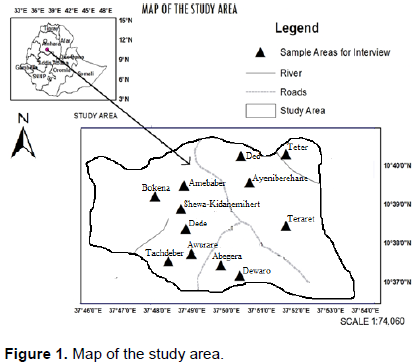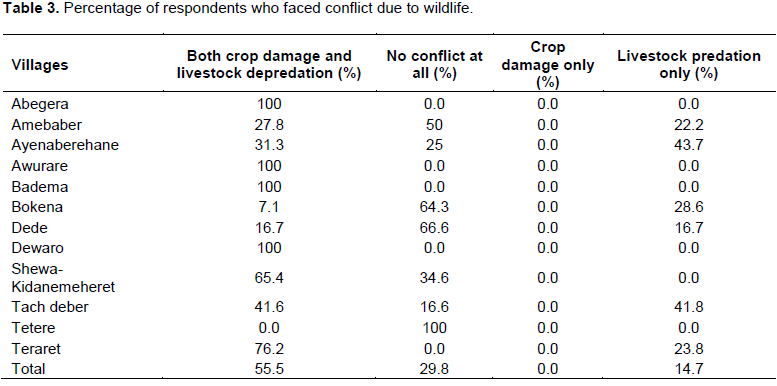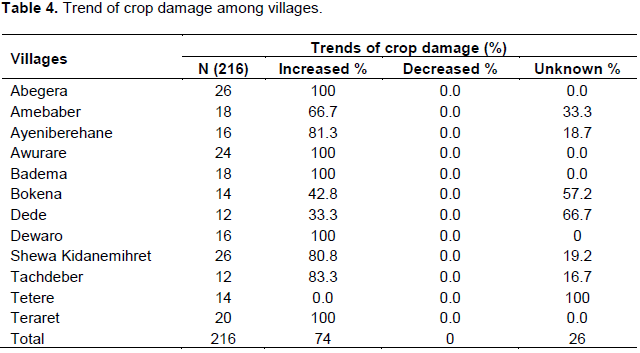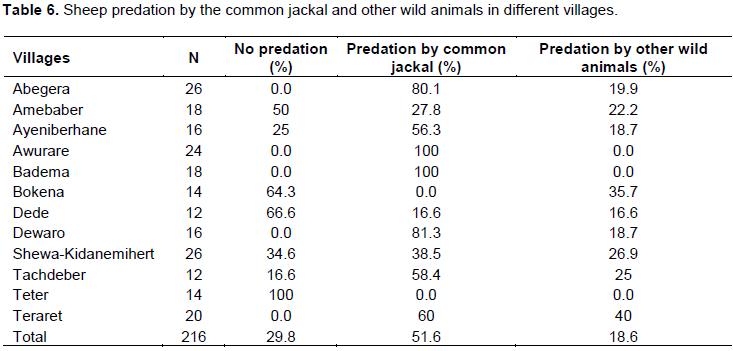ABSTRACT
Human-wildlife conflict is widely known situation where people and wildlife share common resource. This study was conducted to investigate the perceived impact human-wildlife conflict (HWC) in the Choke Mountains, Ethiopia. Data were collected in 2014 and 2015 using semi-structured questionnaires and focus group discussion. Pearson correlation was used to test the relationship between different factors. Majority of respondents (56%) reported the existence of HWC manifested through both crop damage and livestock predation. Anubis baboon, bush pig and porcupine were identified as major crop raiders in the study area. The most prominent sheep predation was caused by common jackal (51.6%). The average crop loss per household per year was 1.56 ± 0.42 quintal. There was a strong negative correlation between the extent of crop damage event and distance of the study area from forest edge (r = -0.67, P < 0.05). The average sheep loss per household by the common jackal in the last five year was 2.12 ± 0.63. Fire wood collection in the study area is negatively correlated with distance from the natural forest (r =-0.58, P < 0.05). Encouraging local communities to prepare private grazing land from their own farmland and to keep intact the habitat of wildlife should be done.
Key words: Choke Mountain, crop raiding, forest disturbance, predation.
Human-wildlife conflict (HWC) is a well-known phenomenon throughout sub-Saharan Africa. It can result in negative impact on the livelihoods of local people or their resources, and/or the status of wild animal populations or their habitat and has existed for as long as humans and wild animals have shared the same landscapes and resources (Lamarque et al., 2009).
HWC exists in one form or another all over the world as wildlife requirements encroach on those of human populations and involve several animal species (IUCN, 2005; Lamarque et al., 2009). Human-wildlife conflict is becoming one of the most important threats to the survival of many wildlife species and is an increasingly significant obstacle to the conservation of wildlife (Madden, 2008). It is a serious issue in Africa and other developing areas of the world where rapidly growing human populations and expanding settlements are reducing the areas left for wildlife habitat and increasing the interactions between humans and animals (Blair, 2008; Mwamidi et al., 2012).
The transformation of global landscapes from predominantly wild to anthropogenic over the last centuries has created competition between humans and wildlife for space and other resources and it reached on unprecedented levels (Kate, 2012). As wildlife habitat becomes more and more fragmented and wildlife gets confined into smaller pockets of suitable habitat, humans and wildlife are increasingly coming into contact and in conflict with each other (Madden, 2008; Lamarque et al., 2009).
Crop damage and livestock predation by wildlife are major source of economic losses (Dickman et al., 2011). Depletion of food supply in the wild forces wildlife to switch to crops and livestock as their food source (Kolowski and Holekamp, 2006). Human population growth and associated increase in rates of resource use, habitat modification and fragmentation is forcing wildlife’s to live in increasing proximity to humans (Blair, 2008). The highest intensity of conflicts tends to occur where humans live adjacent to protected areas (Conforti and Azevedo, 2003). When humans live adjacent to larger wildlife habitats and increasingly altered their habitat, conflict between human and wildlife may occur (Michalski et al., 2006).
The major objective of the present study is to investigate the magnitude of human-wildlife conflict in Choke Mountains. This study tried to see wildlife species that are responsible for crop raiding and livestock predation.
Study area
Choke Mountain is located in East Gojjam Zone of Amhara National Regional State in Central Ethiopia. The mountain range is located on a plateau that rises from a block of meadows and valleys. The central peak is located at 10°42’ N and 37°50’ E ( Fig. 1); the whole mountain area extends over 10°41' to 10°44' N and 37°50' to 37°53' E and covers an area of about 173,443 km2 (Belay et al., 2013). Its topography is sloppy and mountainous nature, which is sensitive to climatic hazards especially with rainfall variability and intensity. Mean monthly temperature of the area were 17.6°C. In the last ten years the average annual rainfall was 1377.6 mm (ENMSA, 2014).The Choke Mountains range is harboring a high diversity of plant and animal life. There are 49 bird species are recorded. Furthermore, 16 species of large mammals have been recorded to occur in the area. The major natural habitats in the area are moist moorland, sparsely covered with Giant Lobelia (Lobelia rhynchopetalum), lady’s mantle (Alchemilla humania), Guassa grass (Festuca spp.), Red hot poker (Kniphofia spp.), St. John’s wort (Hypericum revolutum), Helichrysum spp., Arundinaria alpina, Erica arborea, Euryops pinifolius, Hygenia spp., Cordia spp., Ficus spp., Echinopis spp., Acanthus sennii, Erythrina brucei, and others (CWRDD, 2014) (Figure 1).

Sampling design
Questionnaire survey and focus group discussion were conducted in villages in the Choke Mountains in 2014 to see the perceived magnitude of human-wildlife conflict. A pilot survey was conducted to check the appropriateness of the questionnaire. Out of 24 kebeles, what is that found in and around Choke Mountains range four kebeles namely Abazazh-Weybeyiny, Shewa-Kidanemihert, Sheme and Dangule were selected through stratified random sampling. In the second stage, each village found in the selected kebeles were categorized in to three groups based on their proximity towards the natural forest edge as near (< 1 km), medium(1-5 km) and far (> 5 km), . Following this, one village from each group was randomly selected. Then a total of 12 villages were selected out of four kebeles. Therefore, Awurare, Badema, and Tachdeber villages were selected from Abazazh-Weybeyiny kebele, from Shewa-Kidanemihert kebele Shewa-Kidanemihert, Amibaber and Bokena villages were selected, from Sheme kebele Ayineberehane, Dede and Tetere villages were selected and Abegera, Teraret and Dewaro villages were selected from Dangule kebele at the estimated distance from forest edge near (< 1 km), medium (1-5 km) and far (> 5 km), respectively.
A total of 216 sample household were selected using simple random sampling techniques. Of these 178 were males and the remaining 38 were females. An allocation of the number of sample households to each kebele was proportional to the number of household head living in each selected kebeles. To have complete data, focus group discussions were made with randomly selected 6-10 respondent in selected villages under the guidance of a moderator.
Data analysis
Data were analyzed using descriptive statistics in a form of percentage and frequency was used to analysis socioeconomic profile of the respondents and responses were compared using chi-square test and one-way ANOVA. Pearson Correlation was used to test the relationship between distance of study village from edge of forest and the damage caused.
The community living in Choke Mountains utilized Aba-Jemie forest as grazing land for their livestock and firewood collection. All of the respondents had no private grazing land. Those respondents that were living closer to the forest efficiently use the resources throughout the year. 46.5% of the respondents utilized the forest as a grazing land for their livestock. There was a significant difference (χ2 = 19.95, df = 11, P < 0.05) among villages in using the forest as a grazing land. Most respondents from Awurare (91.7%), Abegera (76.9%) and Shiwa-Kidanemihret (76.9%) utilized the forest. Thus, Awurare utilized the Aba Jemie forest as grazing land most while Dede, Tetere and Amebaber did not use it at all (Table 1). The duration of grazing in the forest was negatively correlated (r = -0.88, P < 0.05) with distance from the forest.

The respondents used different types of plant species and cow dung as firewood. Some of the plant species were Eucalyptus (Eucalyptus spp), St. John wort (H. revolutum), Erica (Erica arborea), giant lobelia (L. rhynchopetalum), and red hot pocker (Kniphofia spp). There was a significant difference among villages in terms of firewood collection (χ2 = 92.2, df =11, P < 0.001). Most respondents from Awurare (75%), Abegera (69.2%) and some respondents from Badema (44.4%), Teraret (30%), Tachdeber (16.7%) and few respondents from Dewaro (6.25%) collected firewood from the Aba Gemea Forest (Table 2). Collection of firewood is negatively correlated with distance from the forest (r = -0.81, P < 0.001) (Table 2).

Most (71%) of the respondents identified five wild animals as problematic that caused crop damage and livestock predation. These were anubis baboon (Papio anubis), spotted hyaena (Crocuta crocuta), bush pig (Potamochoerus larvatus), common jackal (Canis aures) and porcupine (Hystrix cristata).
Of the respondents, 55.5% of them reported that there were both problem of crop damage and livestock predation to wildlife. Whereas 14.7% of them reported that they faced problem of livestock predation to wildlife. And the remaining, 29.8% did not face any problem caused by wildlife. Result of focus group discussion summarizes that the existence of human-wildlife conflict in all site except Tetere. Respondents were significantly differed in the type of conflict they faced by wildlife in the study area (χ2 = 42.46, df = 2, P < 0.05). 100% and 66.7% respondents from Teter and Dede, respectively reported they did not face any conflict caused by wildlife in the area. Respondents from Awurare (100%), Abegera (100%), Badma (100%), Dewaro (100%), Teraret (76.2%) and Shewa Kidanmeheret (65.4%) were reported the existence of both crop damage and livestock predation particularly sheep (Table 3). Based on the respondents, anubis baboon, bush pig and porcupine caused crop raiding in different degrees. Respondents ranked crop raiding animals according to their level of damage. Porcupine was the most commonly reported crop pest which cause much damage and ranked first.

In the study area, three major types of field crops were grown namely potato, barley and bean in the production season of 2014 in the selected sites. Potato and barley had more size in terms of area coverage on the farmland taken as a sample hence sown in all sites which was 2.5 ha representing 78.4% of the total crop land. Porcupine mainly destroyed potato near maturation stage. Anubis baboon and bush pig were causing damage on crops in all stages from the time of germination to the time of harvest. The average crop loss per household in the year was 1.56 ± 0.42 quintal. There was significant difference on damage event registered by wild animals (χ2 = 97.12, df = 2, P < 0.01).
The result showed that not all crops were equally affected by crop raiders. Most (70.8%) of the respondents claimed that potato was the most vulnerable crop to crop raiders followed by barley (22.2%). Whereas 8% of the respondents reported that bean was the least vulnerable crop to damage caused by wildlife. Most (74%) of the respondents reported that it was increasing (Table 4). All of the respondents from Badema, Abegera, Dewaro and Awurare and 81.3% from Ayeniberehane reported that there was an increase of crop damage by crop raider from time to time. Response on trend of crop damage by crop raiders a mong respondent differed significantly (χ2 = 90.67, df = 2, P < 0.05).

Damage events were significantly differed from site to site (F11 205 = 3.6, P < 0.05). There was a significant negative correlation between the extent of crop damage event and distance of the study area from forest edge (r = -0.67, P < 0.05). As the distance of study village from forest edge decreased damage event registered was high and vice versa. There was also a significant negative correlation between livestock predation and distance from the natural forest (r = -0.93, P < 0.05). Fire wood collection in the study area is negatively correlated with distance from the natural forest (r =-0.58, P < 0.05) (Table 5). Respondents closer to the natural forest collect firewood more frequently. But there was no correlation between family size and firewood collection (r = 0.14, P > 0.05).

Majority (70.2%) of the respondents reported that there was damaged livestock by wildlife in the study area while 23% lost their livestock to wildlife. Respondents ranked wildlife which cause livestock predation from the one which causing most damage to the one that cause the least damage. Common jackal was the most commonly reported predator and killed more livestock and ranked first. In focus group discussion also, most respondents reported that there was a strong conflict between local peoples and common jackal. Of the respondent who reported that there was a conflict in their villages about 40.8% of them lost their livestock especially sheep either to common jackal, Anubis baboon or hyena in the last five years. Out of these respondents 51% reported as lost sheep to common jackal alone. In focus group discussion most of the respondents reported that the loss of sheep to common jackal was common to the community. The average sheep loss per household by the common jackal in the last five years was 2.12 ± 0.63. On the other hand, the reported sheep loss to the common jackal differed (χ2 = 68.3, df =11, P < 0.001) among villages. All of the respondents from Tetere reported the absence of predation by wildlife but all of the respondents from Awurare and Badema reported predation by the common jackal (Table 6).

Distance of villages from the forest edge and sheep predation were negatively correlated (r = -0.96, P < 0.05). Thus, distance from the forest edge was considered as the determinant factor for sheep loss to common jackal. There was also correlation (r = 0.09, P < 0.05) between predation by the common jackal and the number of sheep per household. Those who had large number of sheep reported greater loss of sheep to the common jackal than those who had less number of sheep.
Response on trend of livestock predation among respondents differed significantly (χ2 = 90.67, df = 3, P < 0.001). About 54.6% of the respondents reported that it is increasing whereas 15.6% of them said it is unknown and finally no one reported that the trend of livestock predation was decreasing (Table 7). In focus group discussion also, the majority of respondents reported that trend of livestock predation by common jackal was increasing.
Among the different wild animals,Anubis baboon, bush pig and porcupine caused crop raiding in different degree and respondents ranked crop raiding wild animals from the one which causing most damage to the one that cause the least damage. Aharikundia and Tweheyo (2011) reported that baboons and bush pigs were crop raiders in Uganda. Other reports also explained that worldwide primates and bush pigs were among the species most frequently cited by farmers as notorious crop raiders, capable of causing heavy crop damage; porcupine are also involved (Sillero-Zubiri and Switzer, 2004). Both studies agreed with the present study.
The percentage of crop loss increased as the distance between natural forest edge and the study village decrease. There was negative correlation between crop damage and distance from natural forest (r = -0.67, P < 0.05). The result was in agreement with finding of Hill (2000) and Fungo (2011) who reported that farms most at risk to losses of crop were near to the forest edge than far from the forest. Whereas disagreed with finding of Gubbi (2012) who reported farmland at a distance of 3.1-5.0 km experienced more conflict than farmland at a distance 0-1.0 km from Nagarahole National Park, India.
Respondents mentioned common jackal, spotted hyena and anubis baboon were the most important predators of livestock. A study in Brazil reported that livestock predation by mammalian carnivore is the most frequent sources of conflict between human and wildlife (Conforti and Azevedo, 2003). However, the conflict with common jackal was serious. From the total predated livestock 73.5% was by common jackal in the last five years. Sheep predation by common jackal was more intense. This result was in agreement with Getachew (2010) who reported that human conflict with jackals was very serious compared to other carnivore predators due to sheep predation. Spotted hyena is another problematic animal for the local community but the loss livestock to spotted hyena as result of carelessness of the owner. Unless the livestock are left on field during night time spotted hyenas do not dare to come close to human settlements and attack livestock.
Among villages sheep predation by common jackals was very significant (P < 0.001). Distance of villages from the forest edge and sheep predation were negatively correlated (r = -0.96, P < 0.05). Distance from the forest edge was considered as the determinant factor for sheep loss to common jackal. The result was in agreement with study in SMNP showed that distance from the park was correlated with sheep loss to the Ethiopian wolf (Mesele et al., 2008). According to the present study, 54.6% of the respondents reported that the trend of livestock predation by common jackal is increasing but no one reported that the trend of livestock predation was decreasing.
The local people had no sufficient private grazing land therefore keep their sheep during the day time away from settlement area in communal grazing fields mainly in the Aba Jemie forest edge. The majority of respondents from Awurare, Abegera and ShewaKidanMihert have serious problem of grazing land and they were using largely the forest for grazing livestock as they close to the forest. Decreasing distance of the villages from the forest increased the frequency of grazing in the forest (r = -0.88, P < 0.05). Similarly as reported by Getachew Simeneh (2010), livestock from nearby villages stay for longer time in Guassa conservation area than villages from far away.
Firewood collection is negatively correlated with distance from the forest (r = -0.58, P < 0.001). Respondents closer to the forest collect firewood frequently from the forest. Thus, most respondents from Awurare (75%) and Abegra (69.2%) collected firewood from natural forest. The result was in agreement with Mesele et al. (2009) reported in SMNP who lived closer to the park collect firewood more frequently than those who lived far from the park.
Conflict between human and wildlife existed since the dawn of humanity and is an increasing concern in all parts of the world particularly in developing nations where peoples depend on agriculture. The present study investigated the prevalence of human-wildlife conflict in Choke Mountains and manifested through crop damage and livestock predation. The cause of human wildlife conflict were wildlife habitat disturbance, increased agricultural land around forest edge, proximity to natural forest, nature of the area hence it is forest area and the contribution of all mentioned causes.
Porcupine was the most commonly reported crop raiders and golden jackal was the most common wildlife causing domestic animals depredation. Crop raiders cause significant loss on farmers’ production. Potato was the highest vulnerable crop to damage whereas sheep were the most vulnerable livestock. The trend of crop damage was increasing from time to time. In general, Most of the biological diversities, ecosystems and functions in Choke Mountains are heavily threatened. A mechanism should be required where both the wildlife and people live without affecting one another.
The authors have not declared any conflict of interests.
REFERENCES
|
Aharikundira M, Tweheyo M (2011). Human-wildlife conflict and its implication for conservation around Bwindi, Impenetrable National Park, USDA forest service proceedings RMRS-p-6. pp. 39-44.
|
|
|
|
Belay S, Benjamin FZ, Mutlu O (2013). Agroecosytem analysis of the Choke Mountain Watersheds, Ethiopa. Sustain. 5:592-616.
Crossref
|
|
|
|
|
Blair A (2008). Human-wildlife conflict in Laikipia north, Kenya: comparing official reports with the experiences of Maasai pastoralists. J. Appl. Ecol. 41:89-112.
|
|
|
|
|
Conforti VA, de Azevedo FC (2003). Local perceptions of jaguars (Panthera onca) and pumas (Puma concolor) in the Iguacu National Park area, south Brazil. Biol. Conserv. 111:215-221.
Crossref
|
|
|
|
|
CWRDD (Choke Watershed Research and Development Directorate), (2014). Debre Markos University, Ethiopia. P 5.
|
|
|
|
|
Dickman A, Macdonald E, Macdonald D (2011). A review of financial instruments to pay for predator conservation and encouraging human carnivore coexistence. PNAS. 108:13937-13944.
Crossref
|
|
|
|
|
ENMSA (Ethiopian National Meteorology Service) (2014). Meteorological report of ten years 2003-2013. Ethiopian National Meteorology Agency, Addis Ababa, Ethiopia.
|
|
|
|
|
Fungo B (2011). A review crop raiding around protected areas, Kampala, Uganda. Environ. Res. J. 5(2):87-92.
Crossref
|
|
|
|
|
Getachew S (2010). Habitat use and diet of golden jackal (Canis aureus) and human-carnivore conflict in Guassa community conservation area, Menz, (MSc Thesis), Unpublished, Addis Abeba University, Ethiopia. pp.57.
|
|
|
|
|
Gubbi S (2012). Patterns and correlates of human elephant conflict around a south Indian reserve. Biol. Conserv. 148(1):88-95.
Crossref
|
|
|
|
|
Hill MC (2000). Conflict of interest between people and baboons, crop raiding in Uganda. Int. J. Primatol. 21(2):91-98.
Crossref
|
|
|
|
|
IUCN (2005). Preventing and mitigating human-wildlife conflicts: WPC Recommendation. pp. 139-218.
|
|
|
|
|
Kate K (2012). Possible strategies/practices in reducing wild animal (primate) crop raids in unprotected areas in Hoima District, Uganda. P 20.
|
|
|
|
|
Kolowski JM, Holekamp KE (2006). Spatial, temporal, and physical characteristics of livestock depredations by large carnivores along a Kenyan reserve border. Biol. Conserv. 128:529-541.
Crossref
|
|
|
|
|
Lamarque F, Anderson J, Fergusson R, Lagrange M, Osei Owusu Y, Bakker L (2009). Human-wildlife conflict in Africa: cause, consequences and management strategies. Conserv. Biol. 17:1512-1520.
|
|
|
|
|
Madden F (2008). The growing conflict between humans and wildlife: law and policy as contributing and mitigating factors. J. Int. Wildlife Law Policy 11:189-206.
Crossref
|
|
|
|
|
Mesele Y, Afework B, Zelealem T (2008). Human-Ethiopian wolf conflict in and around the Simien Mountains National Park. Int. J. Ecol. Environ. Sci. 34(2):149-155.
|
|
|
|
|
Mesele Y, Afework B, Zelealem T (2009). Human-wildlife conflict in and around the Simien Mountains National Park. Ethiopian J. Sci. 32(1):57-64.
|
|
|
|
|
Michalski F, Boulhosa R, Faria A, Peres A (2006). Human-wildlife conflicts in a fragmented Amazonian forest landscape: determinants of large field depredation on livestock. Anim. Conserv. 9:179-188.
Crossref
|
|
|
|
|
Mwamidi D, Nunow A, Mwasi SH (2012). The Use of indigenous knowledge in minimizing human-wildlife conflict: the case of Taita Community, Kenya. Int. J. Curr. Res. 4(2):26-30.
|
|
|
|
|
Sillero-Zubiri C, Stwizer D (2004). Management of wild Canids in human dominated landscapes. People and wildlife initiative, wildlife conservation research unit, Oxford University, UK. P 16.
|
|